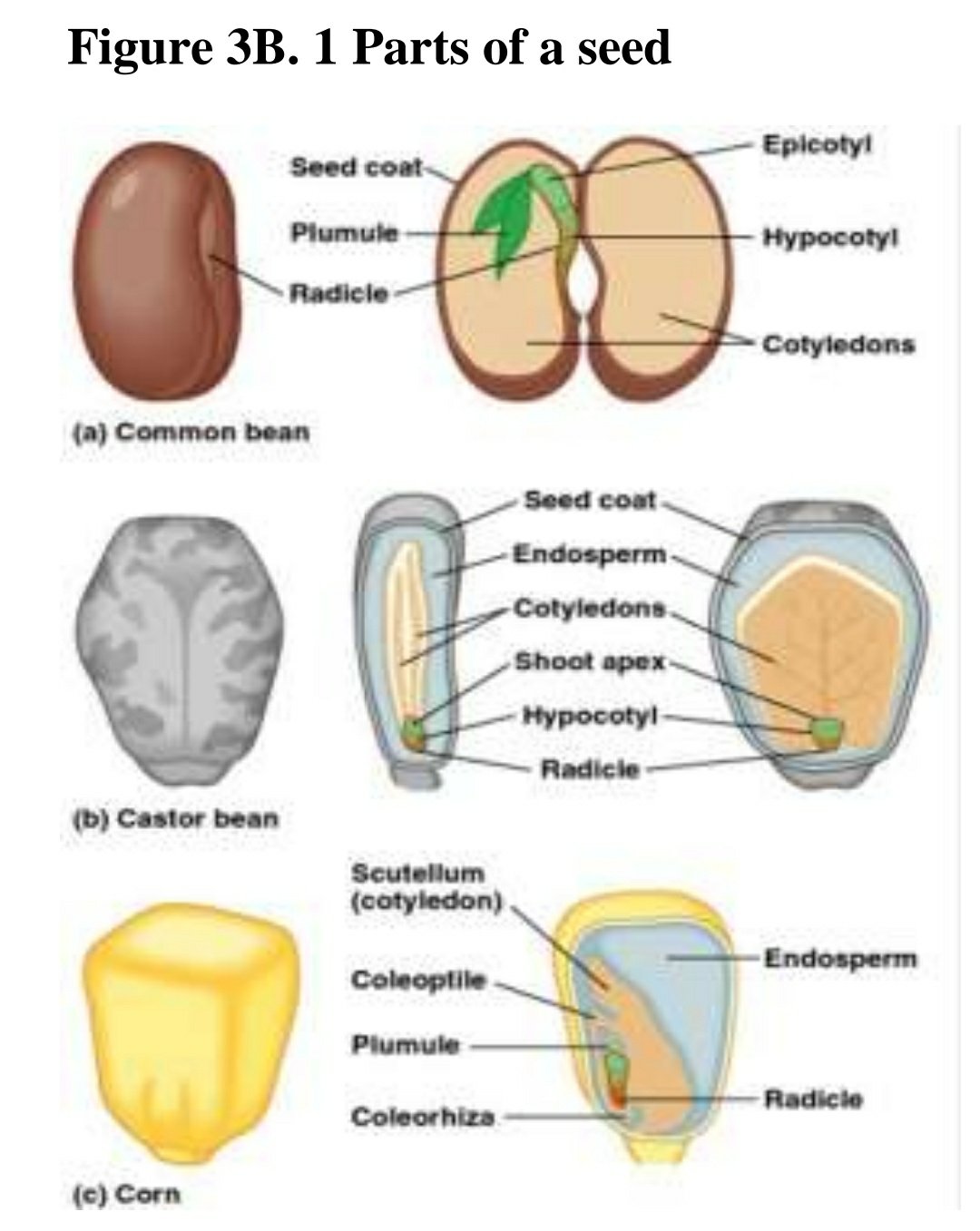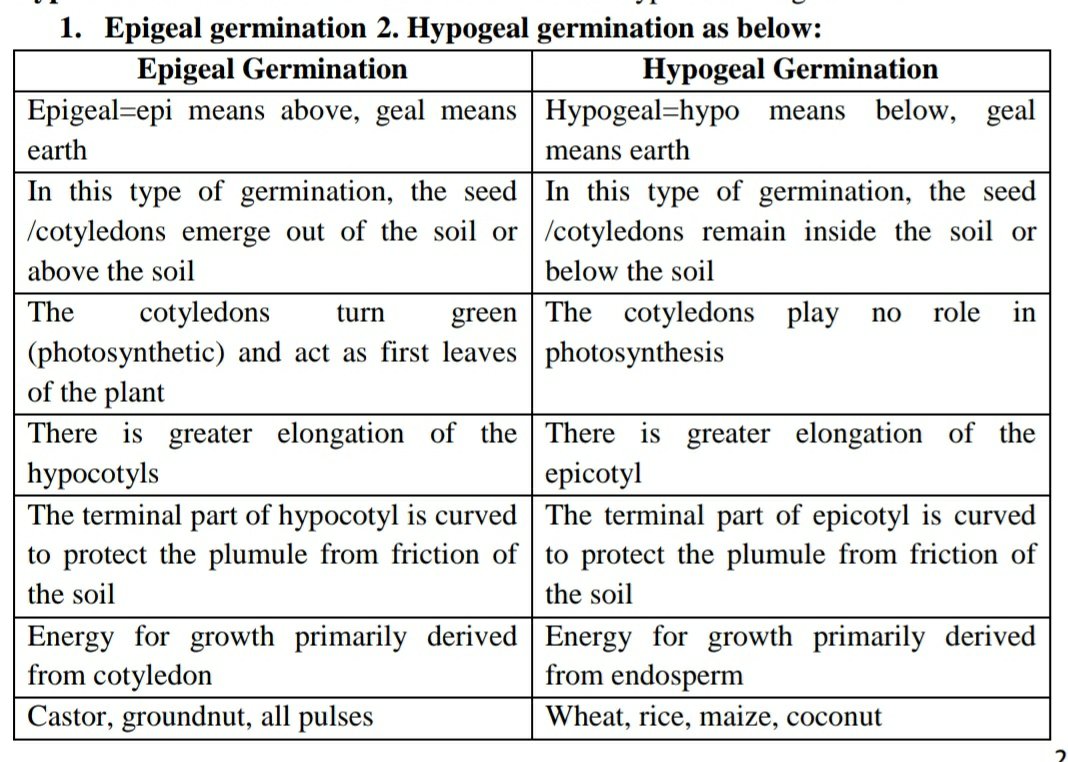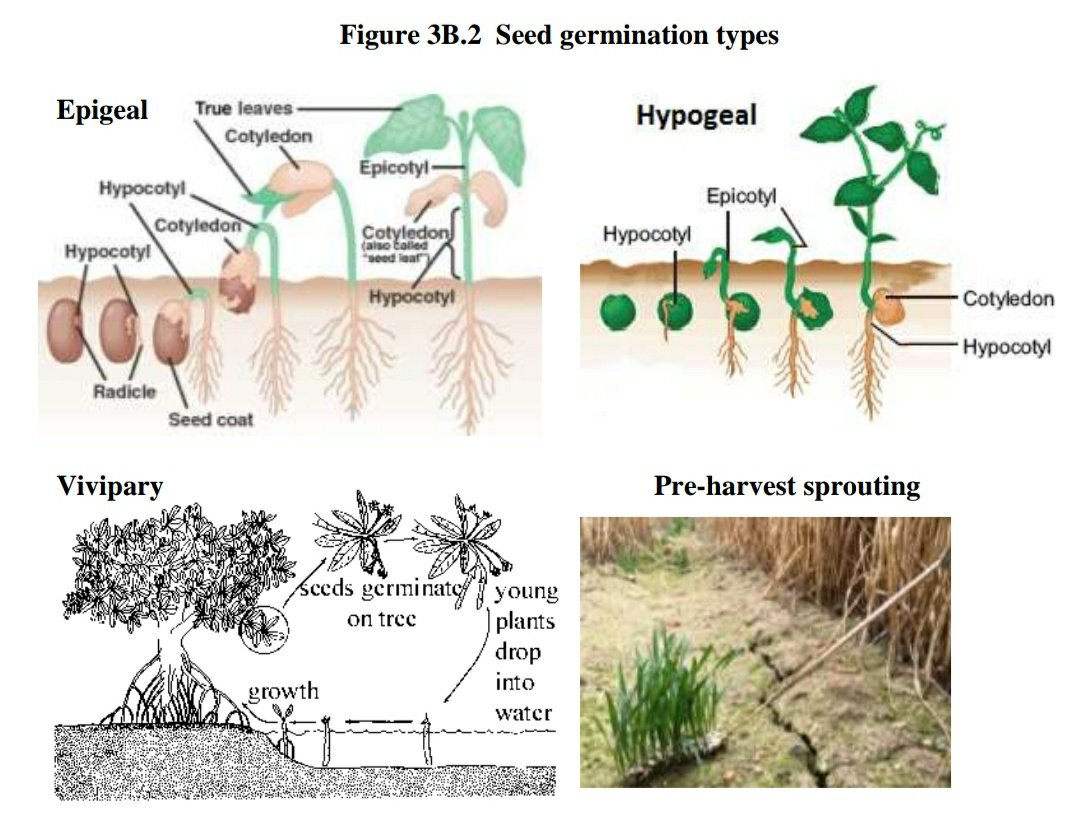Exercise: 3B
Seed and Germination
Seed: It is a mature ovule consisting of an embryonic plant together with a food storage tissue surrounded by a protective seed coat. Or Seed is a ature integumented megasporangium
Parts of a seed (Figure 3B.1)
A. Seed coat: 1. Testa (Outer integument of ovary, dried) Sometimes these two are
2. Tegmen (inner integument of ovary, dried) fused and not separable
Function: Seed coat gives necessary protection to the embryo of the seed
B. Kernel: Contains embryo (rudimentary plant developed from fertilized egg)
I. Embryo: Contains one (monocotyledon) or two cotyledons (Dicotyledon) Cotyledons are also known as seed leaves attached to the embryonic-axis Within the kernel following parts are visible.
Funicle: Attachment point of seed to placental tissue; scar of funicle on seedcoat is hilum
Micropyle: Small opening next to hilum, seeds absorb water through it
Raphe: Longitudinal structure from hilum to downward
Tigellum: Future axis, cotyledons are attached to it
First node: Point of attachment of cotyledon/s to tigellum
Radicle: One end of tigellum, rudimentary root, comes out first from germinating seeds
Plumule: Other end of tigellum, rudimentary shoot
Hypocotyl: Portion between first node and radicle
Epicotyl: Portion between first node and plumule
Mesocotyl: Region between cotyledonary node and coleoptiles
II. Endosperm: Sometimes remnant of nutritive tissues is present, then seeds are called albuminous
Function: It supplies the food to developing embryo
III. Perisperm: Papery white, remnant of nucellus inside seed coat
Types of seeds
According to presence or absence of endosperm and number of cotyledons, four types of seeds are there.
1. Dicotyledons, exalbuminous: Two cotyledons, no endosperm; Pisum sativum, Cicer areitinum, all beans, tamarind, mango, jackfruit, cucurbits, sunflower, mustards, sesame, flax, orange, lemon, oak, Different parts of seed pomegranate
2. Dicotyledons, albuminous: Two cotyledons with endosperm; Ricinus communis, papaw, jute, cotton, water lily, black pepper, coffee
3. Monocotyledons, exalbuminous (very rare): One cotyledon, no endosperm; Amorphallus campanulatus, Vallisneria, Alisma plantago
4. Monocotyledons, albuminous: One cotyledos with endosperm; Triticum spp., Zea mays, Allium cepa
Seed Germination
Seed Germination: It is the process by which the dormant embryo wakes up and begins to grow (Figure 3B.2).
Fulfillment of necessary conditions makes the radicle come out first through micropylar opening.
Necessary factors for germination
External factors: Moisture, oxygen, optimum temperature, light
Internal factors: Food and auxins, completion of resting period (dormancy), viability
Types of Seed Germination: There are two main types of seed germination:
1. Epigeal germination 2. Hypogeal germination as below:
Special Type of Germination:
Vivipary: Seeds germinate within fruit while still attached to plant; Rhizospora sp. Kandelia
Special vivipary: Mangrove plants growing in sea coasts and salt lakes show a special type of germination of seeds, known as viviparous germination. The seed germinates inside the fruit while still attached to the mother tree and nourished by it. The radicle elongates, swells in the lower part and get stouter. Finally, the seedling separate from the mother plant due to its increasing weight and falling vertically, becomes embedded in the soft mud in the soil. The radicle presses in to the soil and lateral roots are quickly formed for proper anchorage; Rhizophora, Avicennia, Sonneratia.
Pre harvest germination: Seeds germinate in spike befor harvesting due to high rainfall, moisture; wheat, rice
Questions
1. Define
i. Germination ii. Seed iii. Seed coat iv. Embryo v. Endospem
2. Differentiate:
a. Albuminous and exalbuminous b. Epigeal and hypogeal germination
3. Draw neat and labeled diagram of epigeal and hypogeal germination.
4. What is seed? Explain different parts and types of seed.
5. Write a short note on special type of germination.



